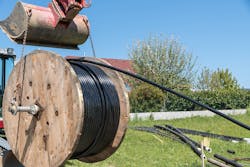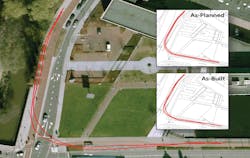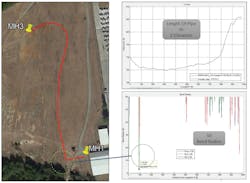Forget Time Travel – Let’s Duct Travel!
According to a study by Deloitte, the United States will spend between $130-$150 billion (USD) to upgrade from 4G fiber optic cable to 5G. This massive investment is likely to be far greater if today’s dark ducts are impractical to use.
And why would that occur? Because each time fiber is installed, there is a high likelihood of damage occurring to the underground infrastructure. According to a recent Damage Information Report Tool (DIRT Report), an increasing number of damages to underground pipes are occurring, particularly in metro locations due to underground locating errors. The 2020 report cited an average of nearly half a million events in the last three years. More than 30% of those incidents were caused by inadequate or inaccurate mapping of underground utility pipelines. Figure 1 from the Common Ground Alliance (CGA) Dirt Report 2020 shows this, and the associated locating practices related to those incidents.
5G Fiber Frustrations
While the 5G market is forecasted to grow from $31 billion in 2020 to $11 trillion (USD) by 2026, it cannot reach its potential without fiber deployment and cell site densification.1
However, there are a number of notable events that have delayed its rollout:
- Fiber Counts: Looking back on the emergence of 4G, who could have envisioned the increase in fiber count for 5G would double or triple—with a range of 3,456 to 6,912 fiber strands in a single cable. This results in a fill ratio (inner diameter cross section of inner duct compared to outer diameter cross-section of cable) in excess of 80% (industry recommendation is <65%). See the sidebar, “Got Your Fill of the Fill Ratio?”, below for details.
- Cabling Installation: While these cables achieve the smaller diameter goal of the industry, they increase the risk of potential damage during installation. This is due to the combination of limited annular space in the duct and the cable stiffness. The result can be a series of small undulations created in the positioning of the duct along the XY axis as well as in depth (Z). This can cause a sharp increase in drag factor causing fissures in the cable jacket or increased attenuation of the fibers. This often robs 5G cable of up to 40% or more of its transmission capabilities.
- Bend Radius Violations: It is important to recognize that high-density cables have larger ODs, which lead to larger minimum bend radii requirements for the cable installation equipment. Cable bend radius violations are one of the most common causes for signal loss and cable damages. It is preferred to know the duct conditions (XYZ & 3D Bend radius) using Gyro mapping technology before installing expensive Ultra high fiber cables.
- As-Built Discrepancies: Adding to the installation problems are the all-too-common discrepancies between “planned-built” and “as-built” mapping. (See Figure 2.) In order to make existing underground assets serviceable, precise mapping and reporting of each duct is necessary. This allows for accurate as-built maps where installers can confirm that a given cable will in fact successfully feed through the duct.
Under It All
Since the radius of every bend in an underground duct can adversely affect the ability of cable to perform according to cable manufacturers’ specs, knowing the extent of those bends can be critical to understanding the true capacity of the ducts.
The ideal solution would use inertial guidance technology that incorporates 3D instrumentation of gyroscopes, accelerometers, and magnetometers. The tool would travel through cable ducts, to precisely map the path from end to end, including bends, undulations and other deviations that may have been required to route the duct through the congested maze of existing underground infrastructure.
Thankfully, there is a tool fiber installation professionals can use to be more exact in their fiber placement. It leverages Underground Gyroscopic Mapping Technology. This type of mapping technology consists of a gyroscopic measuring probe and software. The probe is composed of an Orientation Measurement Unit (OMU) containing inertial sensors that include fiber optic gyroscopes, accelerometers, and odometers. (See Figure 3.)
With trillions of dollars on the line, contractors and network owners cannot afford to attempt installing 5G cables in existing ductwork that is not adequately mapped. What’s more, they can’t delay installations by ignoring this pre-existing infrastructure.
Therefore, specifications to install ultra-high fiber cable in dark duct must include post-installation bend radius verification. Today’s precision XYZ mapping can increase the efficiency of installing data cables, thus helping increase the pace of 5G fiber deployments.
REFERENCES AND NOTES
1. www.marketresearch.com/Wintergreen-Research-v739/5G-Extending-Human-Eyesight-Senses-12745883/
About the Author: Santosh Saride is VP, Strategy & Business Development, PRISUM Technologies, a division of Condux International, Inc. For more information, please email [email protected] or visit www.prisum.tech. You can also follow us on Twitter @PRISUM_Tech and LinkedIn: https://www.linkedin.com/company/prisumtech.
Got Your Fill of the Fill Ratio?
The fill ratio can be calculated for a fiber optic cable installed in an innerduct or microduct as:
d2<65%
D2
“d” stands for the outer diameter of the cable
“D” stands for duct’s inside diameter
Industry best practice is the Fill Ratio should be less than 65% (or .65) for most effective cable blowing. Likewise, when the fill ratio is greater than 80% it becomes increasingly likely that there is insufficient space around the cable for the viscous drag principle of the air to act on the cable jacket.
About the Author
Santosh Saride
VP, Strategy & Business Development
Santosh Saride is VP, Strategy & Business Development, PRISUM Technologies, a division of Condux International, Inc. For more information, please email [email protected] or visit www.prisum.tech. You can also follow us on Twitter @PRISUM_Tech and LinkedIn: https://www.linkedin.com/company/prisumtech.




